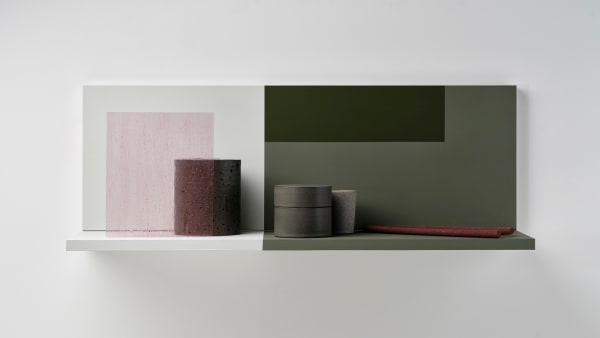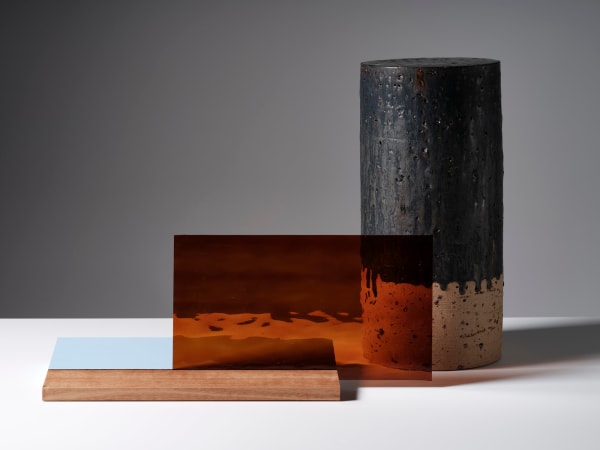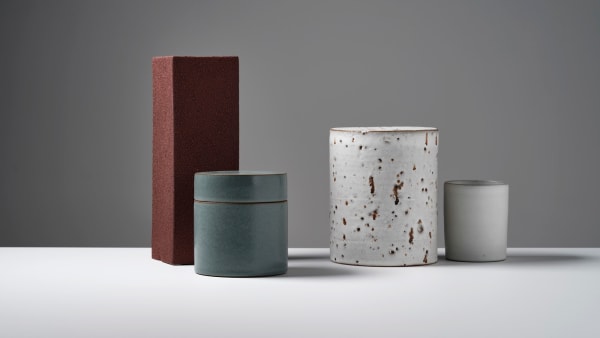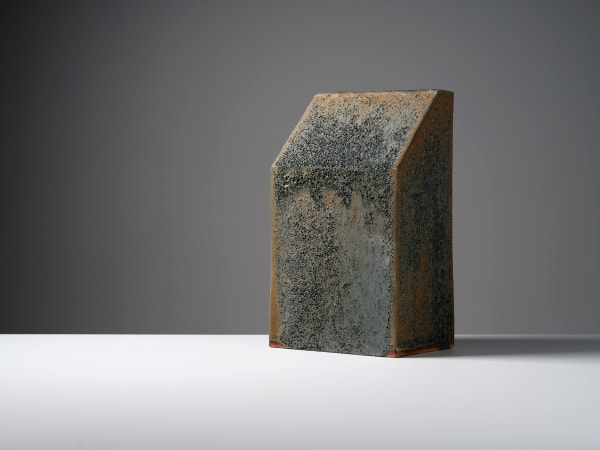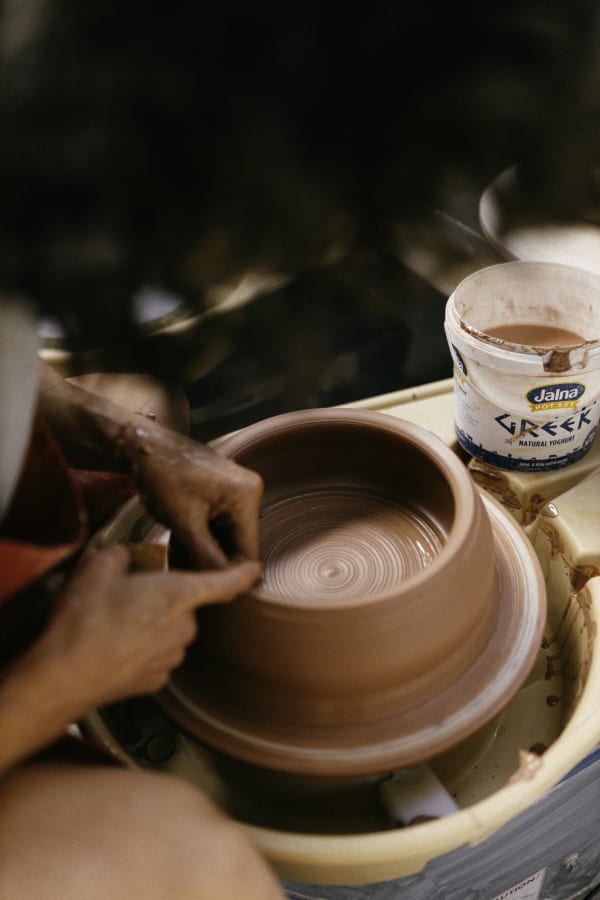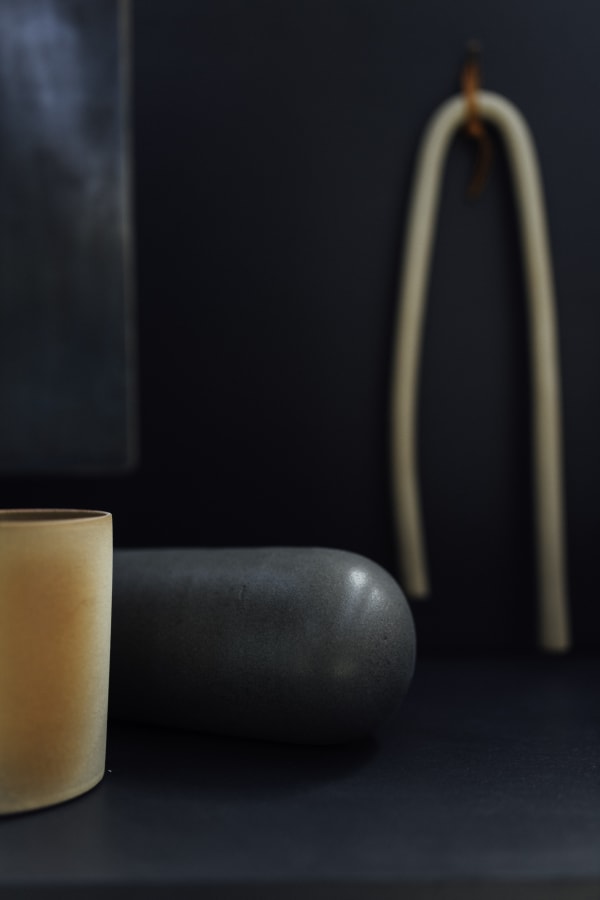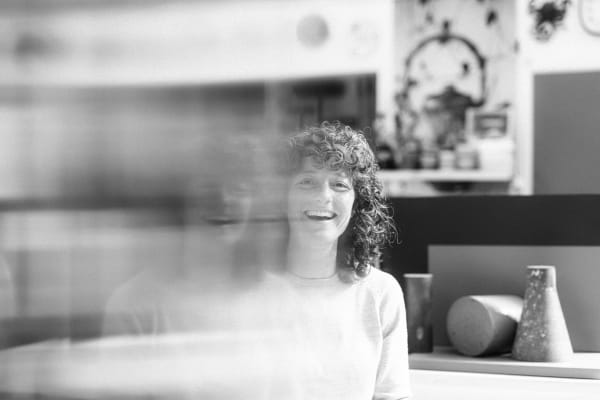My work is about searching for harmony. Like a musical chord, it is about bringing individual components together to create a greater whole; different materials, skills, disciplines and dimensions, with the aspiration of finding a gentle, resonant energy. It is about creating an experience with simultaneous tension and ease, comprehension and confusion, reality and illusion, coolth and warmth.
With the wall-mounted works, ceramic, glass and steel elements are arranged within a spatial field defined by a painted timber frame. These hand crafted objects celebrate the traditions and history of making and the relentless dedication to one’s craft, while at the same time, push against the rigour of efficiency and familiarity of utility. My work asks what happens when something recognisable is placed alongside something abstract? Some objects explore the edge of comprehension, the liminal space between the familiar and the unknown. Yet despite their potential differences, components are interwoven through sympathetic formal devices.
This work gently leans into the realm of painting, with particular attention paid to the ability of colour to establish relationships: some, that attract with opposition and others, that vibrate with close proximity. The composition of things is also strongly informed by images. Objects are purposefully arranged within a narrow band of space, similar to the scenes found in the still life painting of Jude Rae, where positive and negative space carry equal weight.
And while these works borrow formal devices from the world of images, they are very much physical, three dimensional works, exploiting the potential of material expression and existing in same dimension as the human body; the here and the now. It is the interplay of clarity, contradiction and confusion that my work ultimately seeks to explore and a hold space for.
Kelly Austin, 2024
-
-
-

-
 Kelly AustinConvergence 2, 2024ceramics, porcelain, glaze, collected earthen materials, wire, glass, timber, acrylic paint74 x 125 x 43 cm (overall installation size)Sold
Kelly AustinConvergence 2, 2024ceramics, porcelain, glaze, collected earthen materials, wire, glass, timber, acrylic paint74 x 125 x 43 cm (overall installation size)Sold -
 Kelly AustinConvergence 4, 2024ceramics, porcelain, glaze, collected earthen materials, glass, timber, acrylic paint45 x 122 x 35 cm (overall installation size)Sold
Kelly AustinConvergence 4, 2024ceramics, porcelain, glaze, collected earthen materials, glass, timber, acrylic paint45 x 122 x 35 cm (overall installation size)Sold -

-

-

-
 Kelly AustinConvergence 10, 2024porcelain, stoneware glaze, steel, timber, acrylic paint58 x 56 x 32 cm (overall installation size)Sold
Kelly AustinConvergence 10, 2024porcelain, stoneware glaze, steel, timber, acrylic paint58 x 56 x 32 cm (overall installation size)Sold -

-

-

-

-
 Kelly AustinSpatial Object 10, 2024ceramics, glaze, collected earthen materials18 x 37 x 37 cm (overall size)Sold
Kelly AustinSpatial Object 10, 2024ceramics, glaze, collected earthen materials18 x 37 x 37 cm (overall size)Sold -

-

-
 Kelly AustinSpatial Object 13, 2024ceramics, glaze & collected earthen materials48 x 22 x 22 cm (overall size)Sold
Kelly AustinSpatial Object 13, 2024ceramics, glaze & collected earthen materials48 x 22 x 22 cm (overall size)Sold -

-

-

-
-
Minor falls, major lifts
Briony DownesOften arranged in compact groupings of objects, there is a quiet harmony to Kelly Austin's ceramics. Yet, despite this innate harmony, there is also compositional tension - a balance that appears both tightly honed and effortlessly gentle.
Using the contrasting materials of ceramic, glass and steel, Austin is interested in exploring the union of common utilitarian obiects and abstract forms or textures. In Austin's work, the smooth lip of a deep circular vessel can be covered with earthy grit, combining the familiar with an unexpected finish. Placing these disparate elements together, Austin highlights the essential nature of her materials, from the ceramics that lend themselves to the gestural, to the rigid angular strips of steel and glass that create spatial planes for her compositions.
In Minor Falls. Major Lifts Austin creates a subtle conversation between material, form and colour through arrangements that mimic still-life painting. Throughout the aptly titled Convergence series, slouching pale ceramics drape over the edges of shelves, settling as though they have begun to melt back into the earth. Positioned between line-ups of upright, angular forms punctuated by panes of coloured glass, another convergence presents the viewer with a tall cylindrical vessel and a square of amber coloured glass propped across its facade. Reminiscent of the tannin-stained waterways of the southern Tasmanian wilderness, looking through the glass alters our perception by abstracting our view of the ceramic vessel behind.
The relationships between materials are paramount for Austin and she spends much time arranging each configuration to sit between tension and ease, friction, and harmony. Maintaining similar formal techniques to those London-based artist Jane Bustin uses in her painting and sculpture, Austin relates to the way Bustin employs translucent surfaces to reveal stains and pigments of layers beneath. Bustin also incorporates blocks of colour to mark out space and boundaries. For Austin, boundaries are set by painted squares, strips of steel and angular panes of glass.
The blend of natural and industrial materials, and how ceramics as a medium reflect what Austin refers to as, "the beautiful unevenness" of the natural landscape, subtly informs the formal aspects of her objects. This can be seen in Austin's Spatial Objects series where rough textures are blended into graceful form. Austin collects many of her materials directly from nature, both near and far. Some of her clay has been sourced from Queenstown and a waterway close to her home, while dolomite is gathered from a local quarry.
Texture is also a central part of Austin's material language, and she incorporates materials like vermiculite and coffee grounds into the clay she works with to highlight this. In the firing process, these volatile additives burn away or melt, leaving indentations and an iridescent sheen like the thin-film interference visible on the surfaces of fossil fuels. Additionally, Austin will also cut into her vessels to make marks. Placing these irregular and highly textured forms together with objects that are spotlessly finished and refined adds to the compositional tension Austin seeks.
Looking at all the contrasting elements of Minor Falls. Major Lifts, one can see an affinity to the multidisciplinary work of New York based artist, Merrill Wagner. After growing up in the Pacific Northwest, Wagner has maintained a practice that combines formal elements of abstraction with the textures and shapes of nature. Both Wagner and Austin use multiple mediums to convey balance through contrast, and a persistent connection between Wagner and Austin lies in the way Austin has used her painted slabs of colour as additional compositional elements for her ceramic pieces. In addition to Wagner, there are also connections between Austin's work and the organic modernism favoured by Finnish architect, Alvar Aalto, and in the way Australian architect Timothy Hill has used framing to construct a conversation of materials throughout the interiors of the Ingle Hall project.
Similar to Australian ceramicist Gwyn Hansen Pigott, Austin assembles her pieces after firing. In the early 1980s Hansen Pigott became well-known for the way she brought ceramic vessels together to explore how each finished object changed the perception of another, simply by being in proximity. In turn, Hansen Pigott was greatly influenced by the still life painting of Giorgio Morandi, an Italian artist who experimented with variations in tone, colour and compositional balance by repetitively painting the same bottles and vases.
Reminiscent of Austin's way of thinking in Minor Falls, Major Lifts, Hansen Pigott explained in an interview with Philip Bacon Galleries how she, "started to look more closely at how pots, perfectly contained within themselves, sit with each other, changing each other. I was interested to find what could hold the pots together in a bonding that ... could only be discovered after the firing when everything came into play: lushness, coolness, colour, weight, line."
Like still life arrangements full of texture, shadows and sumptuous form, Austin's Minor Falls, Major Lifts captures the balance between tension and harmony. Offering up gracefully composed collections of diverse objects, Austin masterfully brings order to abstractions of form and colour, presenting to the viewer a true feast for the senses.
-

